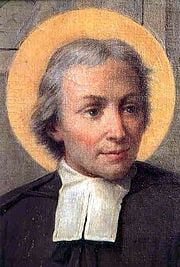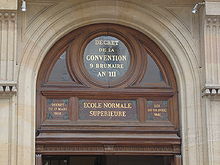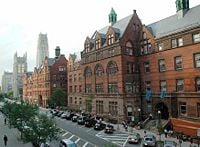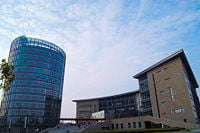Difference between revisions of "Normal school" - New World Encyclopedia
| Line 16: | Line 16: | ||
Before the nineteenth century, teachers were often scholars or clergymen who had no formal training in how to teach the subjects of their expertise. The French concept of an "école normale" was to provide a model school with model classrooms to teach model teaching practices to its student teachers.ref>Anne T. Quartararo, ''Women Teachers and Popular Education in Nineteenth-Century France: Social Values and Corporate Identity at the Normal School Institution''. (University of Delaware Press, 1995. ISBN 0874135451)</ref> The children, the teachers of the children, the student teachers, and the teachers of the students were all together in the same building. | Before the nineteenth century, teachers were often scholars or clergymen who had no formal training in how to teach the subjects of their expertise. The French concept of an "école normale" was to provide a model school with model classrooms to teach model teaching practices to its student teachers.ref>Anne T. Quartararo, ''Women Teachers and Popular Education in Nineteenth-Century France: Social Values and Corporate Identity at the Normal School Institution''. (University of Delaware Press, 1995. ISBN 0874135451)</ref> The children, the teachers of the children, the student teachers, and the teachers of the students were all together in the same building. | ||
| − | In 1685, [[Saint John Baptist de La Salle]], founder of the [[Institute of the Brothers of the Christian Schools]], founded what is generally considered the first normal school, the ''École Normale'',—that is, a school whose purpose is to train teachers—in [[Reims]].<ref>M. Graham, (1910). St. John Baptist de la Salle | + | In 1685, [[Saint John Baptist de La Salle]], founder of the [[Institute of the Brothers of the Christian Schools]], founded what is generally considered the first normal school, the ''École Normale'',—that is, a school whose purpose is to train teachers—in [[Reims]].<ref>M. Graham, (1910). [http://www.newadvent.org/cathen/08444a.htm St. John Baptist de la Salle] ''The Catholic Encyclopedia'' (New York, NY: Robert Appleton Company). Retrieved September 15, 2008. </ref> |
[[Image:Ecole normale supérieure 2.JPG|thumb|220 px|Ecole normale supérieure, Paris]] | [[Image:Ecole normale supérieure 2.JPG|thumb|220 px|Ecole normale supérieure, Paris]] | ||
Perhaps the highlight in the French normal school movement was the creation of The '''École normale supérieure''', a [[France|French]] [[Grandes Écoles|''grande école'']] (higher education establishments outside the mainstream framework of the public universities system). Initially conceived to provide the Republic, under the [[French Revolution|Revolution]], with a new body of teachers, trained in the critical spirit and secular values of the [[Enlightenment]], it was an extremely popular and influential institution for many years, although later it developed into an elite institution which does not deliver degrees as such but grooms France's finest to exercise high level careers, and serve the Nation. Normal schools were often dominated by men in Europe for many years, as men were often viewed as having more intellectual capacity to be scholars than women, although there was shift in this paradigm during the nineteenth century, when women became more popular as private tutors than men. | Perhaps the highlight in the French normal school movement was the creation of The '''École normale supérieure''', a [[France|French]] [[Grandes Écoles|''grande école'']] (higher education establishments outside the mainstream framework of the public universities system). Initially conceived to provide the Republic, under the [[French Revolution|Revolution]], with a new body of teachers, trained in the critical spirit and secular values of the [[Enlightenment]], it was an extremely popular and influential institution for many years, although later it developed into an elite institution which does not deliver degrees as such but grooms France's finest to exercise high level careers, and serve the Nation. Normal schools were often dominated by men in Europe for many years, as men were often viewed as having more intellectual capacity to be scholars than women, although there was shift in this paradigm during the nineteenth century, when women became more popular as private tutors than men. | ||
Revision as of 03:31, 11 October 2008
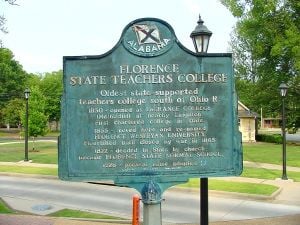
A teachers college, formerly known as normal school, is an institution dedicated to the training and professional development of teachers, most often found in Western post-secondary education systems, although most post-secondary education institutions in the world today have some form of specialized educational programs for the training of teachers. Originating in France during the nineteenth century, many teachers colleges today have been amalgamated into universities and colleges to form Departments of Education.
Purpose
A normal school was a school created to train high school graduates to be teachers. Its purpose was to establish teaching standards or "norms," hence its name. While most of these institutions are now called teachers colleges or teacher training colleges, the same principles apply. Most governments regulate primary and secondary education, and require new teachers to meet established standards and attain certification.
Etymology
The term "normal school" originated in the early nineteenth century from the French école normale, which translates as "Standard" or "Model School"[1] The term is not used often outside of Europe, replaced by teacher's college, so called because almost all collegiate level education programs are sub-departments of larger colleges and universities.
History
Before the nineteenth century, teachers were often scholars or clergymen who had no formal training in how to teach the subjects of their expertise. The French concept of an "école normale" was to provide a model school with model classrooms to teach model teaching practices to its student teachers.ref>Anne T. Quartararo, Women Teachers and Popular Education in Nineteenth-Century France: Social Values and Corporate Identity at the Normal School Institution. (University of Delaware Press, 1995. ISBN 0874135451)</ref> The children, the teachers of the children, the student teachers, and the teachers of the students were all together in the same building.
In 1685, Saint John Baptist de La Salle, founder of the Institute of the Brothers of the Christian Schools, founded what is generally considered the first normal school, the École Normale,—that is, a school whose purpose is to train teachers—in Reims.[2]
Perhaps the highlight in the French normal school movement was the creation of The École normale supérieure, a French grande école (higher education establishments outside the mainstream framework of the public universities system). Initially conceived to provide the Republic, under the Revolution, with a new body of teachers, trained in the critical spirit and secular values of the Enlightenment, it was an extremely popular and influential institution for many years, although later it developed into an elite institution which does not deliver degrees as such but grooms France's finest to exercise high level careers, and serve the Nation. Normal schools were often dominated by men in Europe for many years, as men were often viewed as having more intellectual capacity to be scholars than women, although there was shift in this paradigm during the nineteenth century, when women became more popular as private tutors than men.
Early normal schools in Latin America include several in Mexico, such as the Escuela Normal de Enseñanza Mutua de Oaxaca (1824), the Escuela Normal Mixta de San Luis Potosí (1849), the Normal de Guadalajara (1881), and the Escuela Normal para Profesores de Instrucción Primaria (1887). The Mexican normal school system was nationalized and reorganized by the Secretaría de Educación Pública (Secretariat of Public Education) under José Vasconcelos in 1921.
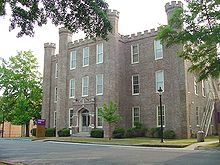
.
Perhaps the oldest continually operating normal school in Latin America is the Escuela Normal Superior José Abelardo Núñez, founded in Santiago, Chile, in 1842 as the Escuela de Preceptores de Santiago under the direction of teminentent Argentine educator, writer, and politician Domingo Faustino Sarmiento. The first normal school in the Dominican Republic was founded in 1875 by Puerto Rican educator and activist Eugenio María de Hostos.
The first normal school in the United States was founded in Concord, Vermont by Samuel Read Hall in 1823. Sixteen years later the first state funded normal school was founded in Lexington Massachusetts, thanks largely to the efforts of education reformers as Horace Mann and James G. Carter[3]. A companion was opened the next year in Bridgewater. Growth forced the normal school's relocation to West Newton in 1843, followed a decade later by a move to the present site on Bare Hill in Framingham. That school, known today as Framingham State College, is the oldest, continuously operated public normal school in the United States. Influenced by similar academies in Prussia and elsewhere in Europe, these normal schools were intended to improve the quality of the burgeoning common school system by producing more qualified teachers.
The United States however did not see women allowed to enter normal schools until around the middle of the 19th century, when small, two-year institutions that granted certificates instead of degrees became popular.[4] With the twentieth century came more increased legislation of education in most parts of the western world, and with it, stricter standards for training and certifying teachers, which in part led to many normal schools being assumed by universities and colleges, switching from non-accredited, certificate granting programs into four year under graduate Bachelor's and three year graduate Master's degrees programs.[4]
Contemporary teachers colleges
In nearly every part of the world, higher educational institutions have taken over the role of educating and licensing teachers, or have set in motion plans to do so. Thus, in Senegal, the former Ecole Normale Supérieure (ENS), Dakar's elite teacher training college, was transformed into the Faculté des sciences et techniques de l'éducation et de la formation (Fastef) in 2008. This move, as with those in other countries, was intended to "allow a greater number of students to enter teacher training, and provide the educational system with an official, quality-controlled workforce."[5]
In the western world, the teacher training institutions are often colleges or departments of larger universities, such as in the United States and many parts of Europe. Often a degree is only one step in many to becoming a teacher. In the United States, most states require an Bachelors and Master's degree along with certification for an individual to be a teacher.
Teachers College, Columbia University is a top ranked graduate school of education in the United States. It was founded in 1887 by the philanthropist Grace Hoadley Dodge and philosopher Nicholas Murray Butler to provide a new kind of schooling for the teachers of the poor children of New York City, one that combined a humanitarian concern to help others with a scientific approach to human development. From its modest beginnings as a school to prepare home economists and manual art teachers for the children of the poor, the college affiliated with Columbia University in 1898, and went on to become the leading intellectual influence on the development of the American teaching profession.
Nowadays all teachers in France are educated in instituts universitaires de formation des maîtres. Both primary and secondary education teachers are required to either have a license or an undergraduate level degree in order to sit for the teacher's examination, which determines who is allowed to enter an education program. These exams are competitive in nature, and for those that score the most, a one year training program is required before they are allowed to teach.[6]
Those who wish to become teachers in the United Kingdom must posses either a Bachelor's degree in Education along with a postgraduate education certificate or have a bachelor's degree in any field with a postgraduate education certificate.[7]
In China and Taiwan, normal schools still exist as separate institutions and are usually controlled by the national or provincial government, while other state run colleges also provide teacher programs.
In most parts of the world, education degree programs are broken up into several different specialties. Students usually chose which level of education they wish to study and become licensed in Early education, Primary education, or Secondary education. Early and Primary education teacher's often gain a general knowledge of many different subjects, while secondary education majors often concentrate and are licensed in one or two areas, such as mathematics, science, art, language or history. Some types of educators, such as Special education and Physical education teachers receive addition, special training along with choosing which level to teach on and gaining generalized knowledge.
Curricula
Although there cultural variations exist as to the scope and function of teachers, most parts of the world recognize the following categories as essential skills and training for future teachers. Some of the following categories have even been taught since the early days of Normal schools:
- Foundational knowledge and skills—usually this area is about education-related aspects of philosophy of education, history of education, educational psychology, and sociology of education.
- Content-area and methods knowledge—often also including ways of teaching and assessing a specific subject, in which case this area may overlap with the first ("foundational") area. Increasingly, emphasis is placed upon 'transversal' or 'horizontal' skills (such as 'learning to learn' or 'social competences', which cut across traditional subject boundaries, and therefore call into question traditional ways of designing the Teacher Education curriculum (and traditional ways of working in the classroom).
- Practice at classroom teaching or at some other form of educational practice—usually supervised and supported in some way, though not always. Practice can take the form of field observations, student teaching, or internship.
Notes
- ↑ "normal school." The American Heritage® Dictionary of the English Language, Fourth Edition. Houghton Mifflin Company, 2004. Answers.com 16 Sep. 2008. [1]
- ↑ M. Graham, (1910). St. John Baptist de la Salle The Catholic Encyclopedia (New York, NY: Robert Appleton Company). Retrieved September 15, 2008.
- ↑ Charles Athiel Harper, A Century of Public Teacher Education: The Story of the State Teachers Colleges as they Evolved from the Normal Schools (Greenwood Press, 1970, ISBN 0837139392)
- ↑ 4.0 4.1 Rebecca C. Tansil, "Steps in the History of Standardization of Normal Schools and Teachers Colleges," Peabody Journal of Education 7(3) (1929):164-167.
- ↑ SENEGAL: Elite teacher training college expands University World News Africa Edition, 03 August 2008. Retrieved October 6, 2008.
- ↑ France EuroEducation.net, 2002. Retrieved September 22, 2008
- ↑ United Kingdom EuroEducation.net, 2002. Retrieved September 22, 2008
ReferencesISBN links support NWE through referral fees
- Ogren, Christine A. The American State Normal School: "An Instrument of Great Good". (Palgrave Macmillan 2005. ISBN 1403968381)
- Dover, Linda A. Teachers and Teacher Education in Developing Areas. (Routledge Kegan & Paul 1986. ISBN 0709908865)
- Cook, Constance Ewing. Lobbying for Higher Education : How Colleges and Universities Influence Federal Policy. (Vanderbilt University Press 1998. ISBN 0826513174)
- O'Banion, Terry. A Learning College For The 21st Century (American Council on Education/Oryx Press 1997. ISBN 1573561134)
- Harper, Charles Athiel. A Century of Public Teacher Education: The Story of the State Teachers Colleges as they Evolved from the Normal Schools. Greenwood Press, 1970. ISBN 0837139392
- Crumrin, Timothy. Teacher Education and the Normal School Movement In Indiana History Online, Conner Prairie. Retrieved October 10, 2008.
Credits
New World Encyclopedia writers and editors rewrote and completed the Wikipedia article in accordance with New World Encyclopedia standards. This article abides by terms of the Creative Commons CC-by-sa 3.0 License (CC-by-sa), which may be used and disseminated with proper attribution. Credit is due under the terms of this license that can reference both the New World Encyclopedia contributors and the selfless volunteer contributors of the Wikimedia Foundation. To cite this article click here for a list of acceptable citing formats.The history of earlier contributions by wikipedians is accessible to researchers here:
The history of this article since it was imported to New World Encyclopedia:
Note: Some restrictions may apply to use of individual images which are separately licensed.
